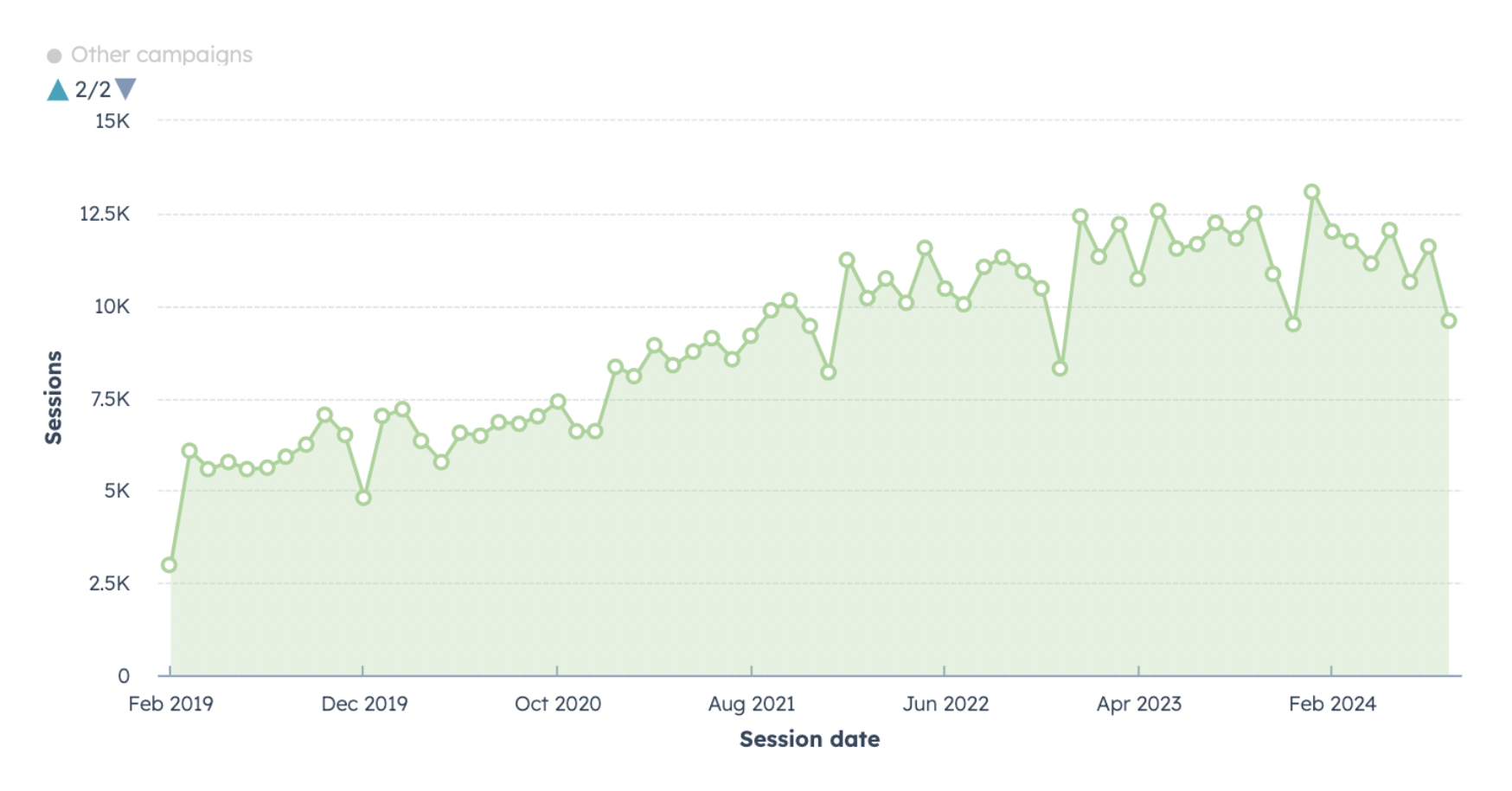How to Build a Content System for AI Search Optimization
Most organizations have websites that look polished but function more like a digital brochure — static, hollow, and not designed to drive measurable growth.
In the age of AI search, that approach no longer works. Visibility, engagement, and ROI come from having a content system — a structured approach to creating and optimizing content that attracts, engages, and converts.
In this article, you’ll learn:
- What a content system is and how it differs from a “brochure site”
- What results you can expect when you build one (with real client data)
- Why optimizing for AI search is now critical to sustain those results
Why a Brochure Site Isn’t Enough
A brochure site may look good, but it doesn’t do much. It rarely generates new engagement, leads, or measurable ROI.
That’s why the first question we’re often asked is: “What results can we expect, and how long will it take?”
What a Content System Looks Like
A content system is different from a brochure site. It’s built on EEAT principles (Experience, Expertise, Authority, Trust) and designed to:
-
Attract new audiences through search
-
Engage them with valuable, educational content
-
Convert interest into measurable actions like sign-ups, donations, memberships, or sales
Since 2013, Yodelpop has specialized in building these systems — not one-off campaigns, but compounding assets like pillar pages, blog clusters, and lead magnets that continue delivering results year after year.
Here’s the difference a content system makes:
Graphic 1: Consistent Content System
This chart shows what happens when an organization consistently implements a content strategy. Traffic grows steadily over time, building a strong, sustainable baseline that supports long-term growth.

Graphic 2: Inconsistent Content Approach
This chart shows a site without a sustained strategy. A partial topic cluster was initiated, but the work wasn’t continued. Without consistent EEAT content, traffic is unstable, with spikes but no lasting momentum.

What You Can Expect from a Content System
Based on results from Yodelpop clients who have followed this approach:
- Clients see on average a ~52% increase in organic traffic year-over-year
- Conversions grow by an average of ~35% year-over-year
- ROI becomes measurable within 12 months, with:
- 40–60% traffic lift
- 25–40% conversion lift
Timeline for Year 1:
- Months 1–3: Content goes live, early conversions begin
- Months 4–6: Rankings rise, engagement grows, leads increase
- Months 7–12: ROI measurable, with steady growth across traffic and conversions
And results compound from there. Once a content system is in place, every new piece adds to an ecosystem of visibility and engagement.
Proof: Our Clients vs. the Industry
Starting in 2023, overall organic traffic to content sites began to decline. Google’s AI Overviews, zero-click searches, and shifting algorithms changed how people discover and engage with information.
But our clients’ systems tell a different story.
Because they’ve been built on EEAT principles (Experience, Expertise, Authority, Trust) for more than a decade, they not only weathered the disruption but continued to see steady traffic and conversion growth.
Now we’re in the next phase: AI search. While many organizations are scrambling to adapt, our clients are already ahead. Over the past year, we’ve been developing the final 15% of optimization — structuring content so it becomes a clear calling card for AI discovery.
Here’s the comparison:
-
General Trend: Content sites without deep EEAT systems have seen sharp declines in organic search traffic since 2023 (insert HubSpot/general traffic chart).

Chart created by Yodelpop with the help of ChatGPT based on aggregated reporting from Similarweb, Parse.ly, Search Engine Land, and HubSpot’s public updates (2021–2025).
-
Client Results: Yodelpop clients show 5 years of consistent growth in organic sessions, blog sessions, landing page engagement, and conversions — and are now optimized to stay visible as AI search takes over (insert your charts).

Real account dashboard in HubSpot last 5 years data to August 31, 2025
The takeaway? EEAT-based content isn’t just resilient — it’s the foundation for growth in the AI era.
Two Steps to AI-Search Optimized Content
Step 1: Build E-E-A-T Content
The foundation of growth is content built on E-E-A-T: Experience, Expertise, Authority, and Trust. This ensures that your site doesn’t just look credible — it is credible in the eyes of both audiences and search engines.
This is the step that has fueled client growth for the past decade.
Step 2: Optimize for AI Search (How You Stay There)
We’re now in the AI search era. Google’s AI Overviews and generative discovery are reshaping how content is surfaced.
EEAT systems are already 85% ready for this shift. The final 15% is about packaging your content so AI can clearly understand it. This is how you stay visible and protect ROI moving forward.
Think of every piece of content as a calling card you hand to AI. The clearer and more structured it is, the more likely it will be surfaced.
How to format content for AI search optimization:
- Structured headings that match search intent
- Concise summaries that deliver answers fast
- Schema markup that gives AI explicit context
- Authority signals like author credentials and trust markers
- Internal linking that connects your content ecosystem
Tracking ROI in the AI Era
Publishing isn’t enough. You need to track the impact.
HubSpot has already introduced AI referrals as a traffic source. For organizations on WordPress + Flodesk or Salesforce MC, we configure analytics to track:
- AI-driven traffic
- Landing page performance
- Conversion lift over time
This ensures ROI isn’t just theoretical — it’s measurable.
Why This Blog Post Is AI-Search Optimized
This very article is structured as an AI-search–ready post. That means it’s written not just for human readers but also for AI systems that now help surface answers in search.
Here’s how it’s built:
-
Clear, query-style headings → so both readers and AI can scan quickly.
-
Front-loaded summaries and data → so answers appear fast, not buried.
-
A simple two-step framework (build → optimize) → so the path forward is obvious.
-
Real-world authority signals → case studies, benchmarks, and client results that build trust.
-
Structured data baked in → HubSpot automatically includes schema markup, giving AI explicit context for what this page is about.
-
An FAQ section → directly answering common search queries in a structured format that AI can easily pull into results.
Think of this article itself as a calling card for AI. It’s packaged so that when AI search scans it, it can lift out the most relevant answers to the exact questions your peers are asking.
The Takeaway
If your website is still just a brochure, you’re invisible in the new era of search. To succeed, you need to:
- Build a content system that attracts, engages, and converts.
- Optimize that system for AI search so you stay visible as discovery shifts.
Ready to move beyond the brochure site? Let’s talk about building your content system for growth in the age of AI search.
Frequently Asked Questions
Q: How long does it take to see ROI from a content system?
Most clients begin to see measurable ROI within 12 months. Typically, traffic increases by 40–60% and conversions by 25–40% in the first year. Results then compound year over year.
Q: How is a content system different from a brochure website?
A brochure site is static and mainly informational. A content system is dynamic: it attracts new visitors through search, engages them with valuable content, and converts them into leads, donors, or members.
Q: Why is AI search important right now?
Google’s AI Overviews and other generative search tools are changing how people discover content. Without optimization for AI search, even strong content risks becoming invisible.
Q: What steps do I need to take to prepare for AI search optimization?
Step 1 is building an EEAT-based content system. Step 2 is optimizing that system for AI search — packaging your content with structured headings, summaries, schema, and authority signals so it surfaces in AI results.



